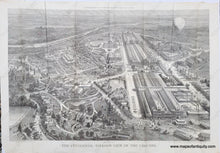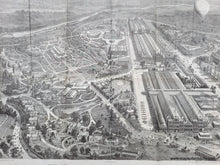Genuine Antique Map
1876
Maker: Harper's Weekly
Antique bird's-eye view map of the Centennial Grounds in 1876, published in Harper's Weekly, September 30, 1876. The Centennial International Exhibition of 1876, the first official world's fair to be held in the United States, was held in Philadelphia, Pennsylvania, from May 10 to November 10, 1876, to celebrate the 100th anniversary of the signing of the Declaration of Independence in Philadelphia. Officially named the International Exhibition of Arts, Manufactures, and Products of the Soil and Mine, it was held in Fairmount Park along the Schuylkill River on fairgrounds designed by Herman J. Schwarzmann. Nearly 10 million visitors attended the exposition, and 37 countries participated in it. More than 200 buildings were constructed within the Exposition's grounds, which were surrounded by a fence nearly three miles long. There were five main buildings in the exposition. They were the Main Exhibition Building, Memorial Hall, Machinery Hall, Agricultural Hall, and Horticultural Hall. Apart from these buildings, there were separate buildings for state, federal, foreign, corporate, and public comfort buildings. The Main Exhibition building took eighteen months to complete and cost $1,580,000. The building was surrounded by portals on all four sides. The east entrance of the building was used as an access way for carriages, and the south entrance of the building served as a primary entrance to the building for streetcars. The Centennial Monorail featured a steam locomotive and passenger car that straddled a single elevated iron rail. Mass-produced products and new inventions were on display within Machinery Hall. Inventions included the typewriter and electric pen along with new types of mass-produced sewing machines, stoves, lanterns, guns, wagons, carriages, and agricultural equipment. The exposition also featured many well-known products including Alexander Graham Bell's first telephone, set up at opposite ends of Machinery Hall, Thomas Edison's automatic telegraph system, screw-cutting machines that dramatically improved the production of screws and bolts from 8,000 to 100,000 per day, and a universal grinding machine by the Brown & Sharpe Manufacturing Company. Air-powered tools along with a mechanical calculator by George B. Grant were exhibited. John A. Roebling & Sons Company displayed a slice of their 5 ¾ inch diameter cable to be used for the Brooklyn Bridge. New food products such as popcorn and ketchup, along with root beer, were also exhibited. This map is in good to very good condition, with folds as issued and some added creases, wrinkling of the paper, some tiny minor spots, and some wear at the paper edges. Measures approx. 19.75 x 30.25 inches to the neatline. Priced as is- could be backed and colored for an additional cost.
Item Number: TOW719




